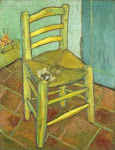.jpg)
"I had a piece of bad luck during my illness -- that lithograph of Delacroix's, La Pietà, along with some other sheets, fell into some oil and paint and was ruined. I was sad about it, so I have been busy painting it ... I have made a copy of it which I think has some feeling." (Letter to Theo, Sept 1889, LT 605)
Although many of van Gogh's paintings possess a spiritual subtext, he rarely created overtly religious images. Part of this derived from his mixed feelings about religion and religious imagery, part of it was practical: he didn't think he should paint important figures like Christ without good models. (This was the reason he gave Theo for abandoning a canvas of Christ in Gethesmane while at Arles.) The handful of Biblical-themed paintings done by Vincent are variations on compositions by other artists, based on lithographs. One of these is the Pietà, painted in early September 1889 after one of his attacks at the Saint-Rémy asylum.
Vincent compared his variations on other artists' works to musical performances, with Délacroix in this case as the composer and himself as the musician, free to interpret the theme as he chose. Because he worked from black-and-white prints, he improvised the color in his versions. His Pietà uses bold blues, and in the background, golden yellows that speak to the Easter sunrise and hope for resurrection. He emphasizes lines and curves, the slumping body of Christ echoing the lines of the rocks at right, and in perhaps the most personal element, gives Christ red hair. In a "Raising of Lazarus" study near the end of his stay at the asylum (based on a print by Rembrandt), Lazarus is given red hair as well; perhaps this was Vincent's way of consoling himself in his suffering, identifying himself with suffering figures of the New Testament. Hope is here, though, just Vincent believed he would eventually recover from his illness.
The Pietà canvas seems to have been special to him. It was one of the few he took to Auvers-sur-Oise after leaving the asylum, instead of storing it in Paris with Theo, and it must have been in his room at the Auberge Ravoux when he died. Theo took it back to Paris, and today it hangs in the Van Gogh Museum, never sold by the van Gogh family. The ruined Délacroix lithograph remains in the museum's collection, too.






No comments:
Post a Comment